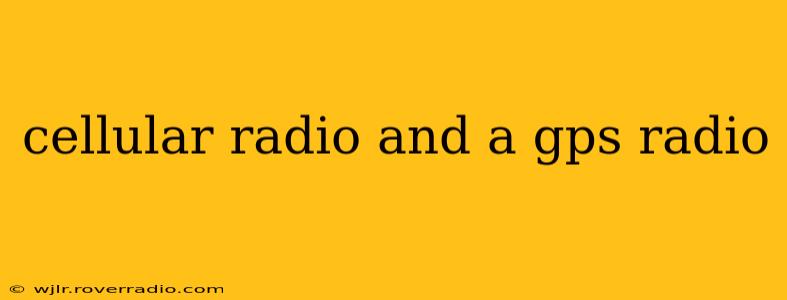Cellular radio and GPS radio, while both relying on radio waves for communication, serve vastly different purposes and operate under distinct principles. Understanding their key differences is crucial for anyone working with wireless technologies or simply curious about how these systems function. This article will delve into the specifics of each, comparing and contrasting their functionalities, technologies, and applications.
What is Cellular Radio?
Cellular radio, the backbone of our mobile phone networks, utilizes a network of base stations (cell towers) to provide voice and data communication over a wide geographical area. It relies on a complex system of frequency allocation, switching, and handoffs to ensure seamless connectivity as users move between different cells. The technology continuously evolves, with each generation (2G, 3G, 4G, 5G) bringing significant improvements in speed, bandwidth, and latency.
Key characteristics of cellular radio:
- Two-way communication: Cellular radio facilitates bidirectional communication, allowing users to send and receive data and voice calls.
- Wide area coverage: Cell towers are strategically placed to provide extensive coverage across cities, regions, and even countries.
- Dynamic channel allocation: The system intelligently assigns frequencies to optimize network capacity and minimize interference.
- Data and voice: Modern cellular networks support both voice calls and high-speed data transmission for internet access, streaming, and more.
- Multiple technologies: Different cellular technologies (GSM, CDMA, LTE, 5G NR) coexist, each offering distinct capabilities.
What is GPS Radio?
GPS radio, or more accurately, the GPS receiver, utilizes radio waves to receive signals from a constellation of satellites orbiting Earth. Unlike cellular radio, it's primarily a one-way communication system. The receiver passively listens to signals transmitted by GPS satellites, using these signals to determine its precise location (latitude, longitude, and altitude). The radio frequency used is specifically allocated for GPS operation.
Key characteristics of GPS radio:
- One-way communication: The GPS receiver only receives signals; it doesn't transmit data to the satellites.
- Global coverage: The network of GPS satellites provides near-global coverage, except for areas with significant obstacles like dense forests or deep canyons.
- Precise positioning: GPS offers highly accurate location information, typically within a few meters.
- Time synchronization: GPS signals also provide highly accurate time synchronization, crucial for many applications.
- Specific frequency: GPS operates on a dedicated frequency band, minimizing interference from other radio systems.
What are the main differences between cellular radio and GPS radio?
This section directly addresses the core distinctions between these two radio technologies.
1. Communication Type:
- Cellular: Two-way communication (sending and receiving data).
- GPS: One-way communication (receiving only).
2. Purpose:
- Cellular: Data and voice communication between devices.
- GPS: Determining geographical location.
3. Coverage Area:
- Cellular: Wide area coverage through a network of cell towers.
- GPS: Global coverage through a network of satellites.
4. Frequency Bands:
- Cellular: Utilizes various frequency bands depending on the generation and technology.
- GPS: Operates on specific, dedicated frequency bands.
5. Accuracy:
- Cellular: Location accuracy varies, depending on the technology and signal strength.
- GPS: Offers high-precision location information.
Can cellular radio be used for location tracking?
Yes, cellular radio can be used for location tracking, although the accuracy is generally lower than GPS. Techniques like cell tower triangulation and assisted GPS (A-GPS) leverage cellular signals to provide location estimates. However, these methods are less precise than standalone GPS due to factors like signal strength variations and the limited number of cell towers.
How does GPS radio work with cellular radio?
Often, GPS and cellular radio work together. Many devices utilize both technologies. GPS provides precise positioning, while cellular provides data connectivity for transmitting location information to other devices or services. A-GPS, for example, uses cellular data to download GPS satellite ephemeris data, which speeds up the time it takes for a GPS receiver to acquire a position fix.
What are the applications of each technology?
Cellular Radio: Mobile phones, tablets, IoT devices, emergency services, etc.
GPS Radio: Navigation systems, mapping, asset tracking, surveying, precision agriculture, etc.
In conclusion, cellular and GPS radio are distinct technologies serving different purposes. While both utilize radio waves, their functionalities, architectures, and applications are vastly different. Understanding these differences is crucial for navigating the complexities of modern wireless communication systems.
